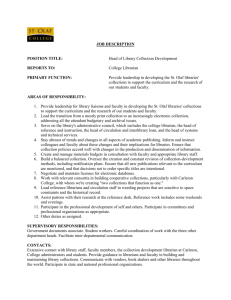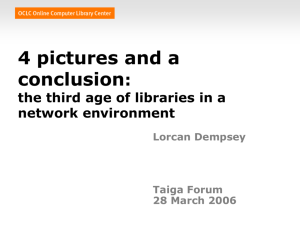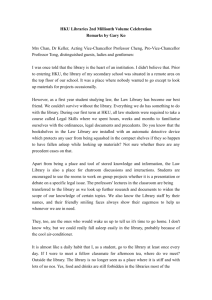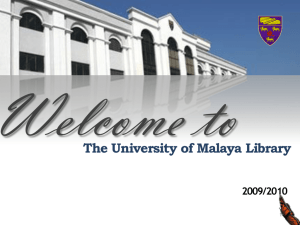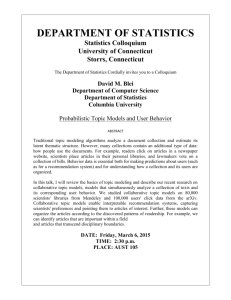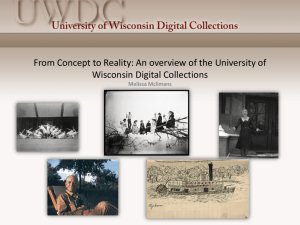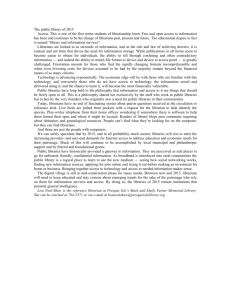Responding to the Radical, New Library Landscape
advertisement
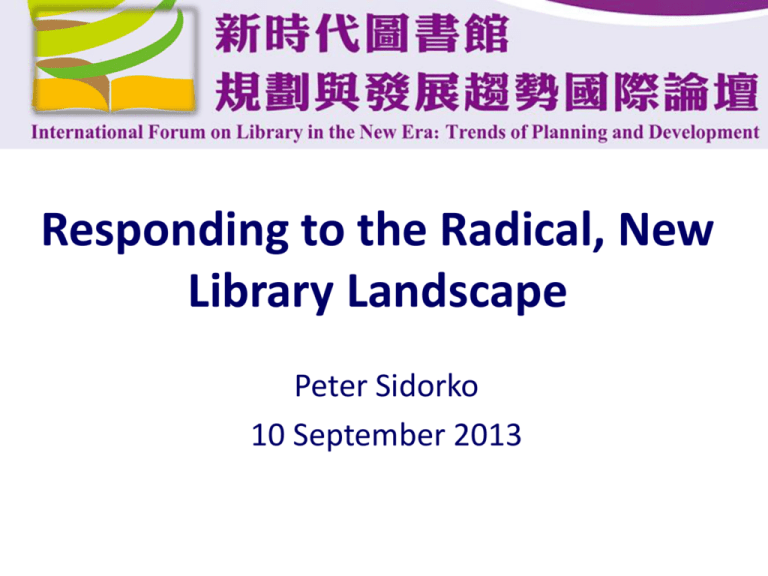
Responding to the Radical, New Library Landscape Peter Sidorko 10 September 2013 But first: Trends in Higher Education Key Trends in Higher Education • Openness: content, data, and resources, along with transparency and ease of access to data and information. • Massively open online courses as alternatives and supplements to traditional university courses. • Graduates need skills acquired from informal learning experiences. • New sources of data for personalizing the learning experience and for performance measurement. • Changing role of educators due to the vast resources that are accessible to students. • New learning/teaching styles to include online learning, hybrid learning, and collaborative models. Horizon Report: 2013 Higher Education Edition, http://www.nmc.org/pdf/2013-horizon-report-HE.pdf Transformational Change in the Information Landscape 1. Collection Size Rapidly Losing Importance 2. Traditional Library Metrics Fail to Capture Value to Academic Mission 3. Rising Journal Costs Inspiring Calls for Alternative Publishing Models 4. Viable Alternatives to the Library Now Boast Fastest Growth and Easiest Access 5. Demand Declining for Traditional Library Services 6. New Patron Demands Stretch Budget and Organizational Culture From: University Leadership Council, Redefining the Academic Library: Managing the Migration to Digital Information Services, Washington, D.C.: Education Advisory Board, 2011. Transformational Change in the Information Landscape Implicit in each of these 6 changes is the impact and role of technology! 1 Collection size • … the Harvard libraries can no longer harbor delusions of being a completely comprehensive collection … Harvard will need to embrace a model that ensures access to— not necessarily ownership of—scholarly materials …” From: Report of the Task Force on University Libraries, Harvard University, Nov 2009. http://www.provost.harvard.edu/reports/Library_Task_Force_Report.pdf Cornell University Library Study, 2010 Approximately 45% of print monographs in the CUL collection published since 1990 have circulated at least once to date; approximately 55% of these books have never circulated. Report of the Collection Development Executive Committee Task Force on Print Collection Usage Cornell University Library . Submitted to the Collection Development Executive Committee October 22, 2010 (revised November 22, 2010). http://staffweb.library.cornell.edu/system/files/CollectionUsageTF_ReportFinal11-22-10.pdf Report of the Collection Development Executive Committee Task Force on Print Collection Usage Cornell University Library . Submitted to the Collection Development Executive Committee October 22, 2010 (revised November 22, 2010). http://staffweb.library.cornell.edu/system/files/CollectionUsageTF_ReportFinal11-22-10.pdf 2 New world, new metrics Traditional metrics • Volumes held • Current serial titles • Total expenditure • Gate count • Loans • Reference enquiries • Presentations Desired metrics • Impact on student enrolment, retention and success • Impact on learning • Contribution to faculty research output • Altmetrics for faculty • Support for grants • Support faculty teaching 3 Rising Journal Costs and Open Access OpenDOAR From : The Directory of Open Access Repositories – OpenDOAR, http://www.opendoar.org/index.html From: http://www.doaj.org/ Projections of Gold OA Growth for ISI-indexed journal articles (data from Springer publishers). Growth will reach 27% of all journal articles by 2020. http://www.richardpoynder.co.uk/Open_Access_By_Numbers.pdf 4 Viable Alternatives: Faster Growth, Easier Access “… Google plans to digitize and make available through its Google Books service approximately 15 million volumes within a decade” (December 2004 press release). Growth and access! 35,000,000 30 Mil scanned books 30,000,000 25,000,000 20,000,000 15,000,000 10,000,000 7.5 Mil Print titles 5.7 Mil ebook titles 3 Mil Print Vols 5,000,000 0 Google 1998 Amazon HathiTrust 1995 2008 3.5Mil ebooks HKU Print HKU e 1912 1912 Growth in Google Books 35000000 30000000 30,000,000 Actual 25000000 20,000,000 20000000 15,000,000 15000000 12,000,000 10000000 7,000,000 5000000 0 Predicted 0 2004 Dec 2008 Nov 2010 Jun 2012 Mar 2013 Apr 2014 Dec 5 Declining Demand for Traditional Library Services • • • • • • • Research support Reference Lending services Interlending Acquisitions Cataloguing and processing … OCLC, Perceptions of Libraries, 2010: Context and Community, A report to the OCLC Membership, 2010. http://www.oclc.org/reports/2010perceptions.en.html Where do faculty begin their research? From: Ithaka S+R US Faculty Survey 2012, Use of Print Materials: HKU 2,000,000 1,800,000 1,600,000 1,400,000 1,200,000 1,000,000 800,000 600,000 400,000 200,000 2006 2007 2008 2009 2010 2011 2012 2013 HKU Remote storage usage Articles Delivered Number of articles scanned 4,500 4,000 3,500 3,000 2,500 2,000 1,500 1,000 500 - 2004 2005 2006 2007 2008 2009 2010 2011 Down 68.8% in 9 years 2012 Hong Kong JULAC Libraries Total Circulation Transactions 7,000,000 6,197,789 6,000,000 5,000,000 5,610,625 6,332,051 6,409,384 6,350,011 6,325,714 6,026,244 6,249,106 6,065,009 5,691,211 5,076,075 4,000,000 3,000,000 2,000,000 1,000,000 - 2002 2003 2004 2005 2006 2007 2008 2009 2010 2011 2012 Hong Kong JULAC Libraries Interlibrary Loans 600,000 531,488 553,227 501,985 500,000 457,240 421,987 390,705 400,000 300,000 239,057 200,000 125,273 131,163 127,961 134,452 2002 2003 2004 2005 100,000 2006 2007 HKALL introduced 2008 2009 2010 2011 2012 6 New Patron Demands Stretch Budget and Organizational Culture • Collaborative physical spaces for Undergraduates • Browsable collections for humanities • Electronic resources for STM • Mobile applications • Expanding special collections • Digitising special collections • Etc… (some) Implications for Libraries 1. 2. 3. 4. Collections and collection building Library spaces Librarian’s new roles and skills Collaborative networks Collections and collection building Key issues • • • • • • • User driven collections Article rentals Unbundling of journals down to article level PPV Ad-supported content “Spotify”cation of scholarly resources New content types: – raw data – peer reviews Library spaces The evolution of the Library as place Collection Client Experience Connection Freeman, G. T. (2005) The Library as place: Changes in learning, patterns, collections, technology and use. In Library as place: rethinking roles, rethinking space. Washington, CLIR. Who informs Library as place? Librarians [What service benefits clients] Clients Institution [What service clients want] [What mission services clients] Bennett, S. (2007) Designing for uncertainty. Journal of Academic Librarianship, 33 (2), 165-179. What informs Library as place? Pedagogy Teaching Learning Research Space Technology Function Network Form Hardware Flexibility Support Radcliffe D. (2008) Designing next generation places of learning: Collaboration at the pedagogy-space-technology nexus. The University of Queensland. Library as Place • Content, technology and services are seamlessly integrated • Flexible - technology, furniture, services, etc • Allow users to self-navigate easily • Zoning for group/collaborative and individual users • Environmentally friendly • Equality of access • 24 x 7 • Shared Librarian’s new roles and skills Ithaka Library Survey 2010 • Priority for teaching and research support but less for acquisition • Growth in information literacy and support for classroom instruction http://www.ithaka.org/ithaka-s-r/research/ithaka-s-r-library-survey-2010/insights-from-us-academic-librarydirectors.pdf Participants in Group Presentations (Median) 18,000 16,000 ARL 14,000 12,000 CAUL 10,000 8,000 JULAC 6,000 4,000 2,000 2000 2001 2002 2003 2004 2005 2006 2007 2008 2009 2010 2011 Number of Group Presentations (Median) 1,000 900 ARL 800 700 CAUL 600 500 400 300 JULAC 200 100 2000 2001 2002 2003 2004 2005 2006 2007 2008 2009 2010 2011 A Slice of Research Life: Information Support for Research in the United States June 2010 • Grant Opportunities • Managing Intellectual Property and Exploiting Commercial Value • Finding Collaborators and Increasing Visibility • Management and Storage of Documents and Data Sets • Improving Information Retrieval and Management Skills http://www.oclc.org/research/news/2010-06-16.htm A Slice of Research Life: Information Support for Research in the United States June 2010 • Managing Citations • Where to Publish or Alternative Forms of Dissemination • Support for Promotion and Tenure • Managing Pre-prints, Publications, and Postprints http://www.oclc.org/research/news/2010-06-16.htm Get in the flow … Collaborative networks • “Civilization exists within the context of … irresolvable tension born of compromise. To reap the benefits of a civilized existence, we need to curb certain natural tendencies. Library consortial activities … embody and reveal several irresolvable tensions.“ • Peters, Thomas A. “Consortia and their discontents.” Journal of Academic Librarianship, 29:2 111-114, March 2003 Typical obstacles to collaboration • “rivalry and competition, mistrust and jealousy, politics and personalities, different institutional priorities and indifferent institutional administrators, unequal development and parochialism … negative attitudes, such as skepticism, fear of loss, reluctance to take risks, and the pervasive lack of tradition of cooperation” • Fe Angela M. Verzosa, The future of library cooperation in Southeast Asia, p.7, 2004 Asian Library and Information Conference (ALIC), 21 -24 November, 2004. Bangkok, Thailand Collaboration Networks • • • • • • • Librarians Libraries Faculty Curriculum designers Students Museums Student support services • • • • • • Teaching support units Learning technologists Pedagogical units Publishers Community Technology vendors The power of collaboration Successful collaborative efforts have: • • • • • Benefit for all the participants Well defined relationships Common goals Commitment of the organizations leaders Comprehensive planning, including: - development of joint strategies and - measures of success i.e. benefits to the user - mutual risk • Shared resources or jointly contracted • Distributed benefits – more is accomplished jointly than could be individually Successful collaborative efforts have: • • • • • • A recognised need Technology is changing the information landscape but it now Positive attitudes also enables “deeper” Communication collaboration than was previously possible. Resources A plan with vision, mission and goals Technology (some times) Radical collaboration “The future health of the research library will be increasingly defined by new and energetic relationships and combinations, and the radicalization of working relationships among research libraries, between libraries and the communities they serve, and in new entrepreneurial partnerships” – Neal, J.G. Advancing from Kumbaya to radical collaboration: redefining the future research library, in Transforming Research Libraries for the Global Knowledge Society (B.I. Dewey (ed.), Oxford: Chandos, 2010 (p. 13). “OCLC’s cloud-based library management services enable libraries to share infrastructure costs and resources as well as to collaborate in new ways” Possible areas for deep collaboration • • • • • • • • • Collection building – distributed collection profiles Acquisition processes Cataloguing Preservation and conservation Binding Reference Storage Administration …. New collaborative networks created by librarians for clients: The Rise of the CRIS (Current Research Information System) IR CRIS • …a database or other information system storing data on current research by organizations and people, usually through some kind of project activity, financed by a funding programme • for researchers: easy access to relevant information • for research managers and administrators: easy measurement and analysis of research activity and easy access to comparative information • for research councils: optimisation of the funding process • for entrepreneurs and technology transfer organizations: easy retrieval of novel ideas and technology and identifying competitors • for the media and public: easy access to information … to allow easilyassimilated presentation of research results in appropriate contexts – From Wikipedia Concluding thoughts • New collections and collection methods • New, innovative and collaborative uses of library spaces • New roles, skills and attitudes for librarians • Collaboration is the single most important key to a successful, sustainable future.

